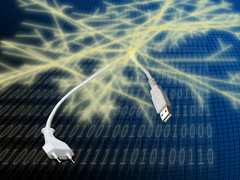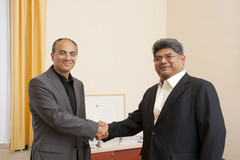
Press Releases
SAVING ENERGY WITH THE "INTERNET OF THINGS"
Pacific Controls and the Vienna University of Technology are developing an “internet of things”. Automatic communication between electronic devices and infrastructures can save money and energy.

Why not save the world, especially if you can make money that way? Dilip Rahulan, CEO of Pacific Controls has an ambitious vision; together with Professor Schahram Dustdar and his team at the Vienna University of Technology, he wants to create networks in which information is automatically exchanged between electronic devices, computers and power grids. Intelligent software, permanently monitoring and controlling the grid, could save great amounts of energy and CO2-emissions. In March 2010, the Pacific Controls “Cloud Computing Research Lab” was established at the Vienna University of Technology. Due to its remarkable success, Pacific Controls has now boosted the research cooperation with another generous contribution of one million Euros.
Making Cities More Efficient
Dilip Rahulan believes that buildings, infrastructure and transport use far too much energy today. We keep heating, cooling and illuminating buildings, even if it is not necessary: “When a building designed for five hundred people is only occupied by ten, the air conditioner is still going at full blast.” Energy could often be saved without losing comfort – but this requires intelligent software solutions, which allow the electronic devices in the building to exchange information. This strategy works even better when whole cities or countries are connected in a network of information exchange. The internet and mobile phones have revolutionized the way people communicate. In a similar way, an “internet of things” could revolutionize our technology, enabling devices, computers, data bases and information networks to exchange information.
Automatic Bots

Schahram Dustdar is working on strategies to establish these networks. Via a software platform, the specific devices have to be controlled in an intelligent and anticipatory way. So called “bots” are being created – smart computer programs, which automatically detect and solve problems in the network. Schahram Dustdar gives an example: “When an air conditioner fails, the bot would automatically locate the problem. Errors in the software would be fixed right away, if there is a mechanical failure, the bot would arrange for repair.” The system has to be designed in such a way that it can be expanded to an arbitrary size. “Scalability is crucial. Energy efficiency increases with the number of networked buildings”, Schahram Dustdar explains.
Saving Money and Lives
This technology can be highly useful in many areas – for example in health care. Which pharmaceuticals are required, and where? What is the current inventory? Where can we expect to need more health care services in the future, due to demographics? A smart network, connecting all this data could save money and lives – starting with simple ideas, such as public defibrillators that automatically call the ambulance in case of emergency.
A Perfect Partnership of Academia and Application
All over the world, Pacific Controls is working with companies, which wish to increase their efficiency using smart networks. In the long run, whole cities, regions or countries could benefit from this network technology. “We have specifically been looking for a university to create a research partnership, and eventually we decided to go with the Vienna University of Technology”, says Dilip Rahulan. The cooperation has been highly successful, and now it is continued and strengthened with additional money from Pacific Controls. “A collaboration between industry and academia as close and focused as this one is something quite rare”, Schahram Dustdar points out. “We have the opportunity to do seminal theoretical science, and at the same time we can work on putting it into practice. For us, this is a perfect situation.”
It is hard to predict where this technological development will lead. “If we knew where our science is going, it wouldn’t be science”, Schahram Dustdar says. Dilip Rahulan and Pacific Controls have ambitious goals; a worldwide net of technology and information should be established, directing energy precisely where it is needed – from office buildings to residential areas, from city to city, from time zone to time zone. There is much to be done - work will never get boring at the Pacific Controls Cloud Computing Research Lab at the Vienna University of Technology.
Picture download: http://www.tuwien.ac.at/dle/pr/aktuelles/downloads/2011/pacificcontrol/
Further information:
Prof. Schahram Dustdar
Institut für Informationssysteme
Technische Universität Wien
Argentinierstraße 8, 1040 Wien
T: +43-1-58801-18414
schahram.dustdar@tuwien.ac.at

